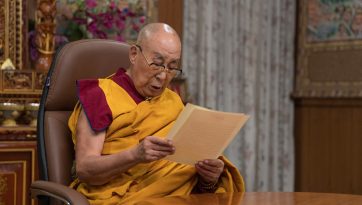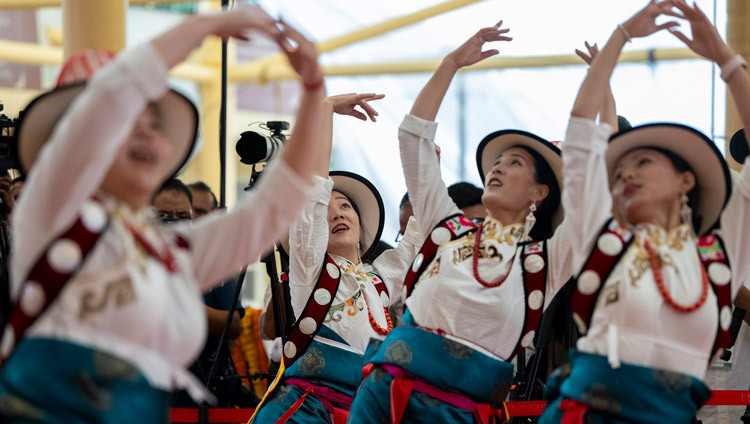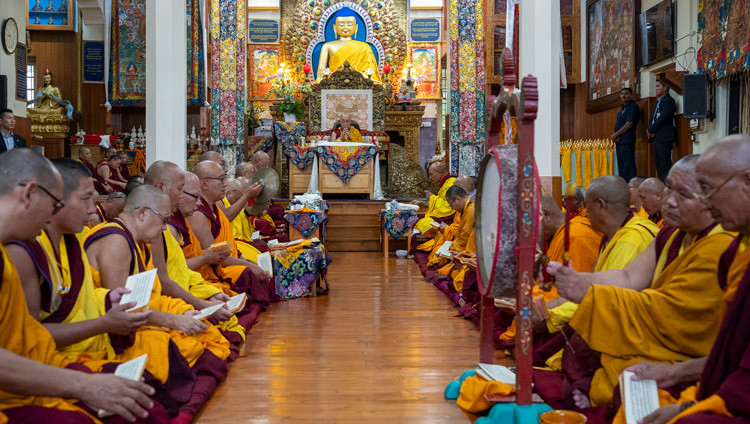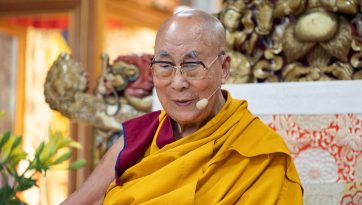The Maha-Satipatthana Sutta – First Day
Thekchen Chöling, Dharamsala, HP, India – This morning, His Holiness the Dalai Lama was invited by a number of Buddhist groups in South and South-east Asia to comment on the Maha-Satipatthana Sutta. The session began with monks in Thailand and Sri Lanka chanting in Pali. Ven Dr Dhammapala Maha Thera wished His Holiness “Good morning,“ and told him how delighted every member of the virtual audience was to be blessed to listen to the teachings. He mentioned that the Mangala Sutta speaks of the benefits of associating with the wise. He then introduced old friends in Sri Lanka, Thailand, Malaysia and Indonesia to His Holiness.
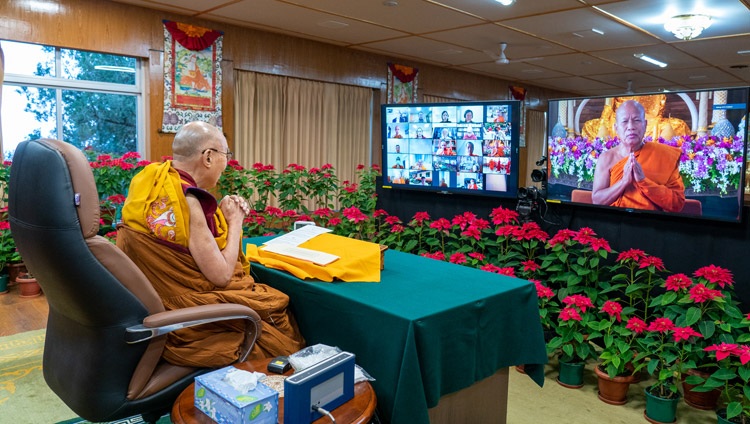
Chief Venerable Phrabhodhinandhamunee delivering the welcome address on the first day of His Holiness the Dalai Lama’s online teaching on the ‘The Maha-Satipatthana Sutta’ on December 17, 2021. Photo by Ven Tenzin Jamphel
From Bodhgaya Chief Venerable Phrabhodhinandhamunee began a short welcome address by reciting a prayer for His Holiness’s long life in Tibetan.
In the heavenly realm of Tibet, surrounded by a chain of snow mountains,
The source of all happiness and help for beings
Is Tenzin Gyatso—Chenrezig in person—
May his life be secure for hundreds of aeons.
He thanked His Holiness for agreeing to comment on the Maha-Satipatthana Sutta that the Buddha himself declared deals with the one and only way to achieve liberation.
He disclosed that the occasion had been organized by a number of groups: Wat Pa Dhammachat Bunyaram Meditation Center, Thailand; Srivijaya State Buddhist College of Tangerang-Banten, Indonesia; Theravada Buddhist Council, Malaysia;
Sri Lanka Tibetan Buddhist Brotherhood Society; ASEAN Dhammaduta Project, Thailand and the Tibetan Buddhist Centre Singapore & Malaysia.
His Holiness responded, “It’s a source of great joy for us to be together, since we are all students of the same teacher—the Buddha. To begin with, I’m going to recite a verse from the ‘Praise for Dependent Arising’ by the 14th century Tibetan teacher, Jé Tsongkhapa.
Becoming ordained in the way of the Buddha
by not being lax in the study of his words,
and by yoga practice of great resolve,
this monk devotes himself to that great purveyor of truth. 53
“This verse is dear to my heart and has influenced me deeply. I had the privilege to take monastic ordination when I was young and it is the basis of my practice of morality. I also had access to a great teacher, Yongzin Ling Rinpoché, and it is thanks to his kindness that I’ve been exposed to the vast teachings of the Buddha, as well as those of the great masters who came after him. I’ve spent time delving into the teachings and have had the opportunity to put them into practice and implement what I’ve learned.
“On the basis of morality, I’ve tried to cultivate the state of calmly abiding (shamatha) that allows us to apply the mind in a concentrated way. In addition, the main focus of my practice is the development of bodhichitta, the awakening mind, the altruistic intention to attain Buddhahood for the sake of all beings. This important instruction derives from what we Tibetans refer to as the lineage of extensive conduct or the lineage of vast practice.
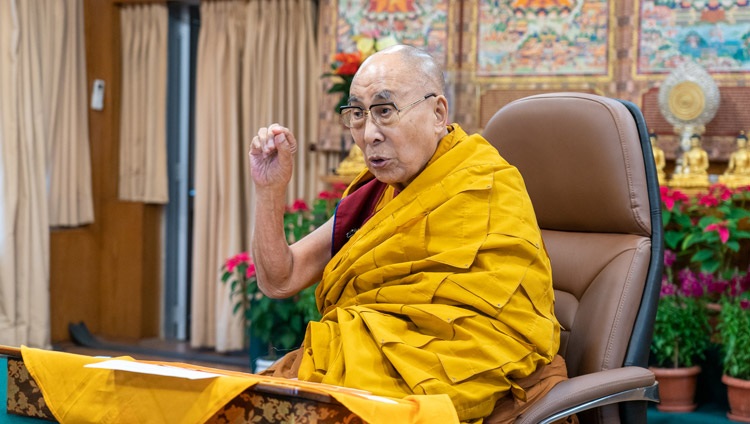
His Holiness the Dalai Lama speaking on the first day of his teaching on the ‘The Maha-Satipatthana Sutta’ online from his residence in Dharamsala, HP, India on December 17, 2021. Photo by Ven Tenzin Jamphel
“The second focus of my practice is the teaching on ‘shunyata’ or emptiness, which entails understanding the deeper nature of reality. This belongs to the teachings of the lineage of profound view.
“The third focus is on teachings coming from the 8th century Indian master Shantideva which pay especial attention to developing an altruistic intention through cultivating a practice known as equalizing and exchanging self and others. It expounds an altruistic orientation of the heart.
“The more I gain from these practices, the deeper is my respect and reverence for the Buddha. As Buddhists we recall the Buddha every day and every morning, I also recite this verse of praise to him:
“Whatever depends on circumstance is empty of nature.”
This teaching is not seen in the works of others,
the title of Teacher, therefore, is yours alone.
Given to others it is but the hollow flattery
of a fox being hailed as a lion. 7
“When we talk about the teachings that have come down to us from the Buddha, we can say there is the Pali Tradition and the Sanskrit Tradition, which largely implies the Nalanda Tradition. The Pali Tradition is well-represented here today.
“Within the Buddha’s teachings there is a diversity of philosophical views. There were initially eighteen schools of thought. Eventually we’ve come to speak of four major schools, the Particularists—Vaibhasika, the Sutra Followers—Sautrantika, the Mind Only School—Chittamatra and the Middle Way—Madhyamaka.
“This diversity makes sense because the Buddha didn’t give one teaching for everybody and he encouraged his followers to examine what he’d taught, “As the wise test gold by burning, cutting and rubbing it, so, bhikshus, should you only accept my words after testing them, and not merely out of respect for me.”
“Since the Buddha gave us the liberty to examine and make sense of the context of his teaching in relation to our own understanding, a diversity of views emerged. Ultimately this examination resulted in some teachings being accepted as literally true and classified as definitive. Others considered to require interpretation were classified as provisional.
“The Buddha taught in order that we understand the nature of reality as it is. This requires us to apply our minds to be able to understand what he said. Every statement of the Buddha can be subject to analysis; can be examined in the light of reason. Such analysis gives rise to a rich faith grounded in reason.”
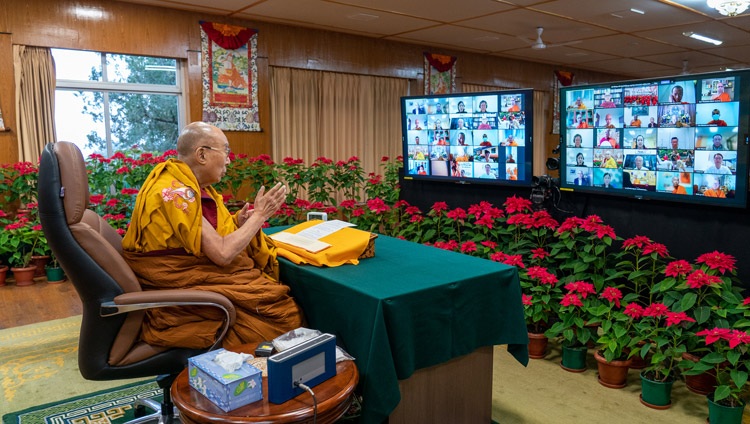
His Holiness the Dalai Lama addressing the virutal audience on the first day of his teaching requested by Buddhist groups in South and South-east Asia online from his residence in Dharamsala, HP, India on December 17, 2021. Photo by Ven Tenzin Jamphel
His Holiness spoke of our living in a world in which there are a multiplicity of spiritual traditions. He suggested that spiritual practitioners need to be able to identify with fellow practitioners belonging to other traditions by recognizing what they all have in common—ethics, avoiding doing harm, cultivating a warm heart and compassion. Along with patience and forgiveness, these are universal values.
He noted that he is a great admirer of the Indian heritage that enables a multiplicity of spiritual traditions—Buddhism, several denominations of Hinduism, Islam, Christianity, Judaism and Sikhism, for example—to flourish together. Another significant component of the Indian heritage that His Holiness admires is ‘ahimsa’, non-violence or doing no harm, which emerges from the cultivation of ‘karuna’ or compassion.
His Holiness cited verses from the end of the sixth chapter of Chandrakirti’s ‘Entering into the Middle Way’ that state that the bodhisattva sees clearly that the three realms in their entirety are unborn from their very start, and through the force of conventional truth, he journeys to cessation. He also generates compassion for beings bereft of protection. And like a king of swans, with white wings of wisdom and compassion spread wide, the bodhisattva soars to the excellent far shore. He remarked that he finds Chandrakirti’s articulation of the aspiration for enlightenment to be deeply meaningful.
He commended the importance of not leaving what you’ve learned as mere knowledge. You have to implement it and integrate it into your own life. This allows you to gain a real taste of the teachings. And it’s on this basis that you will see a transformation in your own mind.
His Holiness observed that since so many members of the Sangha present today are already familiar with the Maha-Satipatthana Sutta he might not need to go through it in detail. He noted that the four foundations of mindfulness play a key role among the Thirty-seven Factors of Enlightenment along with the four supreme endeavours, the four miraculous feet, the five strengths, the five faculties, the seven means to enlightenment and the noble eightfold path.
He suggested looking at a great text like this from the point of view of your own experience. He said he preferred not to view it in isolation, but in the broader context, in this case, of the Thirty-seven Factors of Enlightenment, which involves taking account of the whole map of the path to enlightenment.
He touched on the fact that Dharma practice involves learning, which entails study, listening and reading. A second level includes processing what you have learned in contemplation, confirming your understanding through critical reflection. Thirdly, you internalize whatever you’ve understood and processed in meditation. Ideally, His Holiness observed, you don’t engage in these processes separately or serially. You apply them together. When you can do this, Dharma practice will not be something external to you, but will affect your own state of mind. It will mean you really ascertain what you’ve learned.
An indication of the success of your practice, His Holiness remarked, is reflected in your emotional response to such terms as dependent arising—pratityasamutpada. Without a depth of practice these terms will just remain words. For those who have engaged in intense practice, these key terms will resonate with profound meaning.
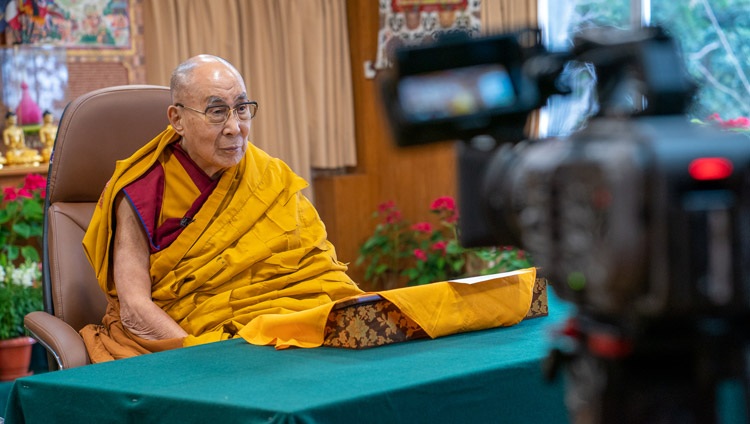
His Holiness the Dalai Lama speaking on the first day of his teaching on the ‘The Maha-Satipatthana Sutta’ online from his residence in Dharamsala, HP, India on December 17, 2021. Photo by Ven Tenzin Jamphel
His Holiness quoted several verses from Shantideva’s ‘Entering into the Way of the Bodhisattva’ which he regards as powerful and which he strives to implement in his own life.
All those who suffer in the world do so because of their desire for their own happiness. All those happy in the world are so because of their desire for the happiness of others. 8/129
For one who fails to exchange his own happiness for the suffering of others, Buddhahood is certainly impossible—how could there even be happiness in cyclic existence? 8/131
Proceeding in this way from happiness to happiness, what thinking person would despair, after mounting the carriage, the awakening mind, which carries away all weariness and effort? 7/30
His Holiness also touched on examining the thought ‘I am’. He declared that grasping at the self is the basis for many negative emotions that lead to self-centredness and attachment. However, he conceded that the notion ‘I’ can be used constructively. He gave the example of Chandrakirti’s sevenfold analysis in which he asked whether the self is identical with the psycho-physical aggregates; whether the self is distinct from the aggregates; whether it resides within the aggregates; whether the aggregates possess the self; whether the self is the configuration of the aggregates; whether it consists in their collection and so forth.
Following such a process leads to the discovery that an independent self is unfindable, so there is no basis for the strong attachment to which it gives rise.
The important point, His Holiness clarified, is that the Buddha’s teachings are not to be regarded as something external to us, but as contributing to our experience. This is why they are relevant and why applying them brings about real change.
Answering several questions from the virtual audience His Holiness noted that when most people encounter difficulties, they tend to try to blame someone else. The instruction about mindfulness and the four noble truths enables us to see causes from a broader perspective. The Buddha taught that suffering and happiness result from our own state of mind. Achieving a more peaceful state of mind strengthens our resilience.
Internalizing the teaching of the four noble truths enables us to appreciate the complexity of the situation we find ourselves in. It means we don’t necessarily have to react negatively.
“The beautiful thing about the Buddha’s presentation of the four noble truths,” His Holiness reiterated, “is that although it begins with suffering, that’s not a reason for becoming demoralized because the third noble truth concerns cessation and leads us to seek the path.”
His Holiness acknowledged that the Maha Satipatthana Sutta can be relevant to people today because it contains the Buddha’s summary of the path. The four noble truths offer a powerful framework. Suffering and its causes, as well as true cessation the true path, are two sets of cause and effect.
One questioner referred to a custom of chanting the Maha-Satipatthana Sutta at funerals and asked whether it was of benefit. His Holiness told him that there is a chance that the deceased will hear it in the intermediate state, which can be of benefit. In addition, chanting the Sutta may help the bereaved family find peace. His Holiness described human consciousness and the body as two different streams of existence. At death the body ceases, but consciousness persists. He compared the intermediate state being to the dream body and went on to discuss dream yoga and lucid dreaming.
His Holiness confirmed that the four foundations of mindfulness, including mindfulness of breathing, deepen the practitioner’s ability to gain mastery over his or her own mind. He outlined the different levels of consciousness explained in the Vajrayana tradition, including consciousness of the waking state, sleep, dream, deep sleep and the clarity and awareness that manifests at the time of death.
Mindfulness also plays an important role in a monk’s being able to protect and preserve his precepts. Being mindfully aware of walking, standing, sitting and lying down as well as sleeping, waking, eating and so forth impact his day-to-day behaviour. His Holiness mentioned that in addition to mindfulness, meta-awareness, or clear knowing, enables a practitioner to closely monitor his or her own behaviour and thought. Such a context makes clear why the monastic precepts were explained in such detail.
The moderator announced the end of the day’s session and expressed the wish that all beings be well and happy. The virtual audience uttered the traditional response, “Sadhu, sadhu, sadhu”, which may be understood to mean, “That’s good, excellent and auspicious.”
………………………………………………………………………………………………………….
SOURCE: https://www.dalailama.com/news/2021/the-maha-satipatthana-sutta-first-day

